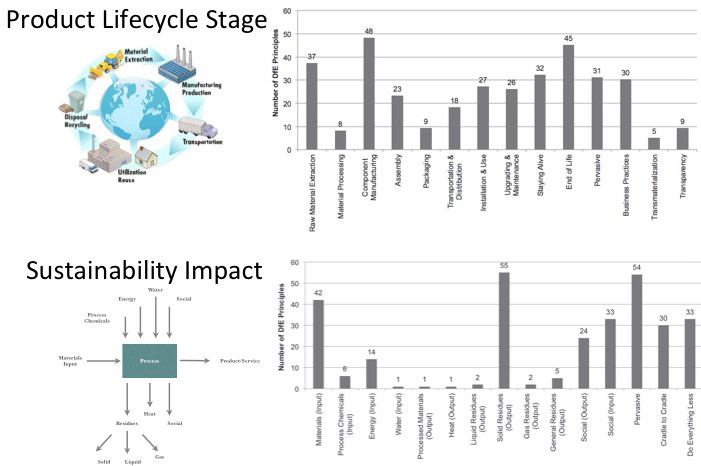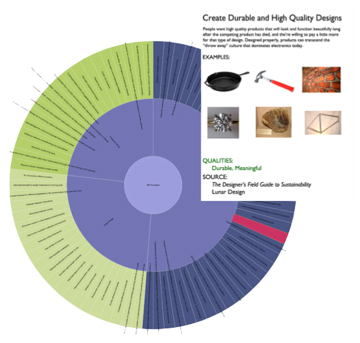Integrating Design for Environment into Design Practice
Team Members: Cole Hartman
Advised by: Lora Oehlberg and Alice Agogino, UC Berkeley
Fall 2010- Spring 2012
Team Members: Cole Hartman
Advised by: Lora Oehlberg and Alice Agogino, UC Berkeley
About the Project:
During my undergrad at UC Berkeley, I participated in Design for Environment research investigating Design for Environment (DfE) principles and their integration into design practice. As part of this project, I conducted a sustainable design literature review and collected over 300 Design for Environment principles and clustered them based on their sustainability impact and relevancy in different parts of the product life cycle and design process. We then used these principles to begin development of a visualization tool to aid in the navigation of DfE principles. A paper describing our work on this project was included in the proceedings of the 19th CIRP Conference on Life Cycle Engineering 2012. The next phase of this research was investigating the social aspect of design for the environment.
Below is the poster we prepared and presented at a Sustainability Fair on the University of California, Berkeley campus Spring '11, receiving Best Poster Award.
Publications:
L. Oehlberg, C. Bayley, A. Agogino, et al (2012). "Mapping the Life Cycle Analysis and Sustainability Impact of Design for Environment Principles" In Proc. CIRP LCE, pp. 221-226

Design for Environment Principles:
One way to practice sustainable design is by following Design for Environment principles.
Design for Environment (DfE) is defined as:
"The systematic consideration of design performance with respect to environmental, health, and safety objectives over the full product and process life cycle." (Fiksel 2009)
DfE principles are guidelines engineers and designers can follow to reduce the environmental impact of their product. Some examples of DfE principles include:

Source: Lunar Design, 'Designer's Field Guide to Sustainability'
Research Objectives:
* Determine which DfE principles affect each stage of the product lifecycle
* Identify which aspects of sustainability or environmental impact are being addressed by DfE principles
* Establish where in the product design process DfE principles should be considered
* Identify which aspects of sustainability or environmental impact are being addressed by DfE principles
* Establish where in the product design process DfE principles should be considered
Methodology:
* Conducted a literature review and collected over 300 DfE Principles
* Coded principles according to three frameworks: Product Lifecycle Stages, Sustainability Impact, & Product Design Process

Results:
By applying this coding scheme to a large number of DfE principles, we can begin to develop a better understanding of where engineers have existing strategies to address environmental and social impact. Below you can see the distribution of DfE principles in the product lifecycle stages. The stages with the majority of principles included raw material extraction and end of life.
Also below is the distribution of DfE principles according to their sustainability impact. The majority of principles are in Materials (input) and Social Residues (output). There are many principles that guide material selection and use in the detail of the design and little guidance on how to address other inputs and outputs. In addition, the framework of social input and social output does not yet capture the complexity of social interactions a company or designer may have with various stakeholders.
By applying this coding scheme to a large number of DfE principles, we can begin to develop a better understanding of where engineers have existing strategies to address environmental and social impact. Below you can see the distribution of DfE principles in the product lifecycle stages. The stages with the majority of principles included raw material extraction and end of life.
Also below is the distribution of DfE principles according to their sustainability impact. The majority of principles are in Materials (input) and Social Residues (output). There are many principles that guide material selection and use in the detail of the design and little guidance on how to address other inputs and outputs. In addition, the framework of social input and social output does not yet capture the complexity of social interactions a company or designer may have with various stakeholders.

Future Work:
After coding the principles, we experimented with some initial ideas for a visualization tool to navigate the database of DfE principles. Future work on this project includes creating the design tool and expanding the inclusion of principles addressing social sustainability.
